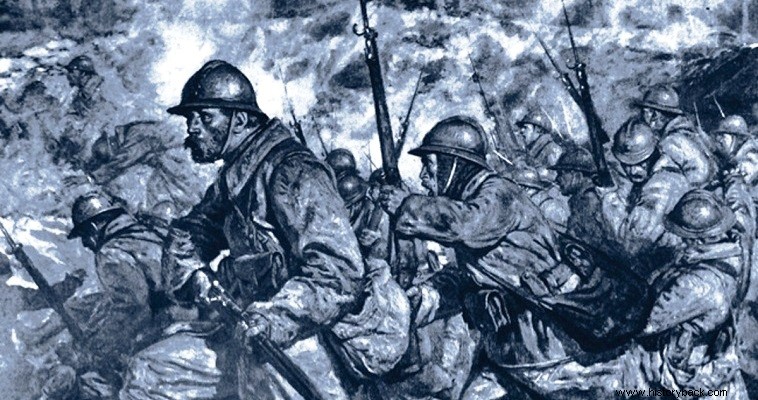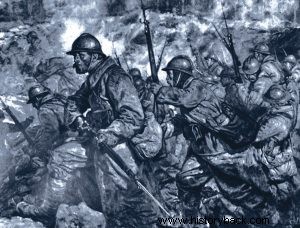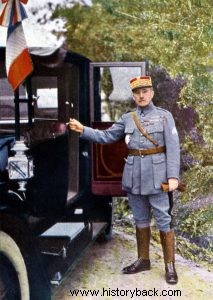
In April 1917 the French army launched the biggest attack on the Western Front up to that time. The attack, based on the plans of the general who initiated it, would completely split the German front and bring victory. Unfortunately for the general in question, the attack only succeeded in causing massive casualties and a revolution in the French army.
Robert Georges Nivelle was born in 1856 to a French father and a British mother. He enlisted in the army in 1878 as a second lieutenant of artillery. He fought in Algeria, Tunisia and China and by 1913 was a colonel. With the outbreak of World War I distinguished himself in the battles of Alsace, the Marne and the Ain and was promoted to lieutenant-general in October 1914.
But his legend was born during the deadly battle of Verdun . There under the orders of Petain he commanded the 2nd Army. But he was not the officer who counted the lives of his men . On the contrary, he wasted them in futile attacks and counter-attacks. However, he was the first to apply the rolling artillery barrage (barrage) in the counter-attacks of October 1916 at Verdun, managing to repel the Germans.
Use artillery primarily against enemy infantry rather than destroying specific targets. At Verdun his tactics proved successful. After the recapture of the Duamont fort, his reputation took off.
So on December 12, 1916 he was assigned command of the French army. With the doctrine "artillery conquers, infantry occupies" with Nivelle in mind, he proposed to the Allied leadership a large-scale operation in the Ain area of the Ladies' Road, which would completely break up the strongly organized German front and end the war in favor of ANTANT.
His plan called for a fierce artillery bombardment of the enemy positions for days and then a bold infantry charge under the cover of a rolling barrage. He would march with four French armies to the Ain area for the big attack - split.
Although there were objections from both British and French generals, including Petain, the Allied leadership eventually accepted Nivelle's plan. However, on April 4, 1917, the Germans carried out a small-scale attack south of the Ain and Nivelle's plans for the upcoming attack fell into their hands. Accordingly they prepared accordingly and waited. Nivel nevertheless refused to change his plans!
The fatal attack
Finally the "Victory Offensive" began on 13 April 1917, a first preparatory attack on St Cunetyn. "The German army will put it on its feet", declared Nivel , being sure of success.
However, everything went wrong from the beginning. The first attack gained little ground. Nevertheless Nivelle launched his main attack on 16 April. However, the preparation of the French artillery proved insufficient against the "Hindenburg Line" , that is, of the strong defense line of the Germans, due to the lack of howitzers.
The French infantry which gallantly charged forward were consequently massacred in front of the German positions. "The commander of a machine-gun company described to me the progress on the battlefield where the best French regiments were destroyed one after another in continuous desperate attacks" , said German Prince William, head of German forces there.
Nivel had estimated that his forces would suffer up to 10,000 casualties on the first day of the attack. It was soundly refuted as the French losses were appalling. Nivelle had promised the French government to stop the attack if he saw that they were succeeding. Nevertheless he ordered the attack to continue.
By April 20 the French had captured 20,000 Germans and captured 147 guns. However the price was almost four times French losses. By April 25 French losses had exceeded 96,000 men (other sources speak of 118,000 men). The French health services, having prepared for a smaller number of casualties, based on Nivel's predictions, were unable to treat the wounded, thousands of whom died.
The attack nevertheless continued. It was finally discontinued on May 9. It had cost the French army 187,000 casualties. This disaster had the consequence of breaking out among the French units. The morale of the French army had collapsed. Nivel removed from management and was sent in command of the forces in northern Africa. He was replaced by Petain, who managed to reorganize the army and suppress, with mostly mild measures, the attitude.
Nivelle returned to France in 1918, retired in 1921 and died in 1924 having associated his name with one of the greatest military disasters in the history of warfare.


